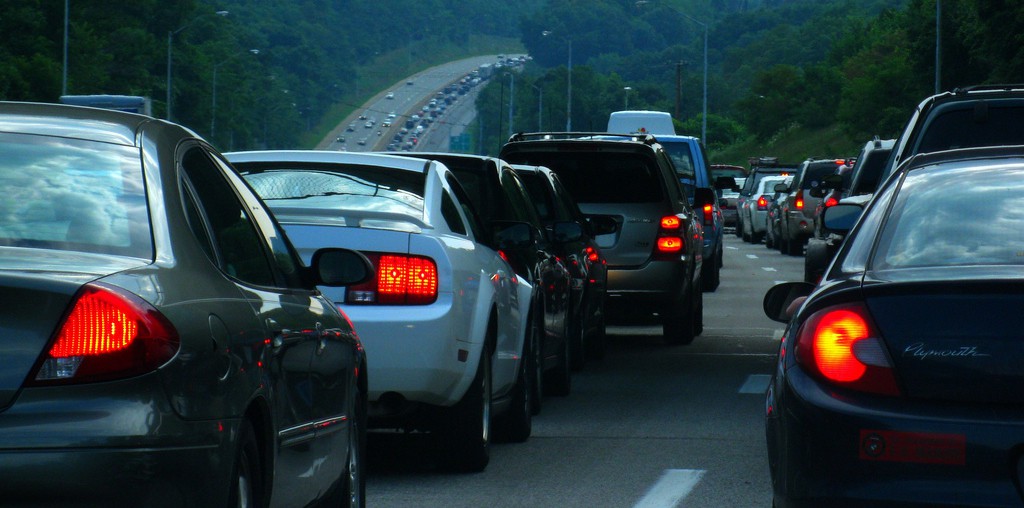New data show roads less congested here
Pittsburgh area motorists travel roads that are less congested than in most major metropolitan areas. While that may come as a surprise to anyone idling in front of the Squirrel Hill tunnel or crawling over the Fort Pitt Bridge, the differences are significant.
Southwestern Pennsylvania drivers lost 39 hours last year stuck in traffic – six hours fewer than the average across Pittsburgh Today’s 15 benchmark regions, according to the Texas A&M Transportation Institute’s latest urban mobility report.
In the aftermath of the recession, traffic delays have been increasing on roads nationwide. But congestion has remained relatively flat in Pittsburgh.
Boston area drivers lost an average of 64 hours in 2014 due to congestion—the most of our benchmark regions. Drivers in the Kansas City, Cleveland and Milwaukee regions experienced annual travel delays similar to Pittsburgh’s. And Richmond motorists traveled the least congested roads among the benchmark regions losing only 34 hours to traffic snarls last year.
“One of the good things about our region is that things tend to be pretty stable,” says Doug Smith, transportation director at the Southwestern Pennsylvania Commission (SPC), which monitors local traffic congestion. “Our commuter peaks tend to be pretty focused. We don’t have gridlocks, six or 10 hours a day like some places – they tend to be pretty narrow windows.”
Economic stability, land use patterns and a public transit network that’s more heavily used than those in most metro regions of similar size all contribute to the stable congestion patterns seen in southwestern Pennsylvania. But while that stability is a long-standing trend, congestion patterns are changing and there is ample room for improving traffic flows, Smith says.
The commute on the Parkway West is one example. “One of the interesting things in recent years is the reverse commute seems to be growing at a faster pace than the inbound commute. In the morning, the delay is increasing if you’re headed out to work at the airport, but remains consistent if you’re headed into the city.”
Back to the future
Congestion has a number of causes, but the economy is the primary driver. Traffic congestion has now returned to pre-recession levels across the country, including in the Pittsburgh region, says Bill Eisele, a Texas A&M Transportation Institute senior research engineer. “What our report is really showing is that we’re seeing this clear relationship between the economy and congestion levels. The downside of a growing economy has been increased congestion levels.”
On a local level, everything from traffic signal issues to work zones cause congestion, so solutions to the problem are diverse and comprehensive.
Some cities, such as Seattle and Minneapolis, are ahead of the curve when it comes to active traffic management. According to Eisele, these regions have begun to use dynamic message signs updated in real time to help manage traffic by reducing or increasing the speed limits to harmonize traffic flow around an accident, work zone, or graded terrain.
Congestion management processes in the Pittsburgh area involve an assortment of approaches and tools. To improve traffic flows through the region, for example, the SPC works with local governments to re-time and coordinate traffic signals, which in Pennsylvania are owned and operated by municipalities. Another program, CommuteInfo, is a one-stop online portal for ridesharing services and other commuting options that reduce traffic congestion.
Traffic 21, a multidisciplinary research initiative at Carnegie Mellon University, applies some of the latest research and technological advances coming out of the university to real transportation issues in the region.
They’ve worked with the Pittsburgh Cultural Trust to develop an app called ParkPgh, which shows real time parking information for parking garages downtown. “Studies show that often times up to 30 percent of downtown traffic can be circulating traffic — people driving around looking for a place to park, or driving around trying to avoid parking,” said Traffic 21 Executive Director Stan Caldwell. Real time information or even predictive information on what garages will be open at a certain time or which garages currently have open spaces helps to reduce such meandering.
On the streets of East Liberty and Bloomfield, Traffic 21’s adaptive traffic signals change color depending on current traffic volume. The project began in 2012 with nine intersections in East Liberty and has expanded to 49 intersections, reaching into Bloomfield. “One of the most efficient ways of reducing congestion is having optimal timing of your traffic signals,” said Caldwell. “We’ve had reductions of wait time of up to 40 percent, so these signals have been very significant there.”
Solving congestion means addressing a range of issues in Pittsburgh and across the nation. “When we talk about solutions to congestion, we have to get as efficient operation of the system as possible,” Eisel says. “On the street that means that the signals are timed appropriately. On the freeways, it means when there are crashes they need to be cleared out as soon as possible. In some cases, we’re just going to have to add capacity – that’s typically roads, but it can also be transit or a rail line.”





